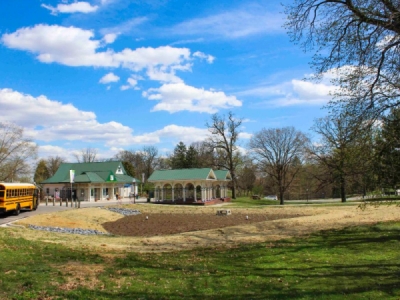
Posted on June 12, 2019
Baltimore Project Improves Water Quality in Chesapeake Bay
BALTIMORE, MD – A stream at The Maryland Zoo at Baltimore that was once eroded has a second life thanks to an ecosystem restoration project funded by the Maryland Department of Transportation Maryland Port Administration (MDOT MPA).
“The Maryland Port Administration is committed to growing the Port sustainably,” said Bill Richardson, MDOT MPA general manager of safety, environment and risk management. “That means taking responsibility for clean water, air and land This stream restoration is the first of its kind for the Port of Baltimore, and we hope it will help educate zoo visitors and the local community about the importance of keeping our waterways clean.”
What was once a heavily eroded streambed stretching about 100 yards is now an enhanced environment that beautifies the zoo and helps improve the health of the Chesapeake Bay. Guests can observe the restored streambed along the zoo’s Buffalo Yard scenic road.
The project, which took four months and was completed this spring, restored the streambed to its original elevation and installed step pools to slow the water flow, provide habitat and curb shoreline erosion. The stream resumes its natural flow at the bottom of the step pools, which are filled with boulders, cobble, sand and woodchips in a cascading waterfall that helps reduce water velocity during significant rains. At each level, impurities and sediment are filtered through the soil beneath the pools. Prior to the project, water gushed through the stream on rainy days toward the Jones Falls.
“We called it the ‘Grand Canyon of the Zoo,’” said Adam Wyatt, Maryland Zoo project manager. “It shows our guests that the zoo is committed to conservation and the environment. Great things can be accomplished for our watersheds and the bay if everyone works together.”
The restoration project also included constructing a bioretention pond near the zoo’s main gate to gather stormwater from nearby roads and parking lots. The pond contains a special soil mix and gravel bed that helps filter out pollutants and directs the water to Waterfowl Lake through underground pipes.
The MDOT MPA provided funding for the project, which was completed by Maryland Environmental Service (MES) of Millersville, designed by Moffatt & Nichol Engineers of Baltimore and landscaped by Bry’s Lawn Care & Landscaping of Forest Hill. The Baltimore City Department of Recreation and Parks partnered with the MDOT MPA for the project.
“MES partners with MPA in many ways that provide environmental benefits for Maryland,” said MES Director Roy McGrath. “This project has important environmental, educational and aesthetic benefits. We are proud to be a part of its successful completion.”
The project highlights the environmental commitment of the MDOT MPA’s GreenPort of Baltimore. The MDOT MPA has funded trash wheels — including its own Captain Trash Wheel — as well as solar compacting trash cans, and planted more than 1,000 trees around Baltimore City. The MDOT MPA has also reduced emissions by almost 20 percent through the Dray Truck Replacement Program, which helps fund the purchase of cleaner running vehicles. The reduction in emissions comes as the Port of Baltimore is handling more cargo than ever before. In 2018, the Port of Baltimore handled a record 43 million tons of cargo valued at a record $59.7 billion.
Among the nation’s ports, the Port of Baltimore ranks first for autos and light trucks, roll on/roll off heavy farm and construction machinery, and imported sugar. The Port ranks second in exported coal, ninth in the total dollar value of cargo and 11th in foreign cargo tonnage.
The 2017 Economic Impact of the Port of Baltimore in Maryland report determined the port generates about 15,330 direct jobs, with more than 139,180 jobs overall linked to Port activities. The average salary for people with direct jobs at the Port is 9.5% higher than the average annual wage in Maryland. The Port is responsible for nearly $3.3 billion in personal wages and salaries, $2.6 billion in business revenues and $395 million in state and local tax revenues.





